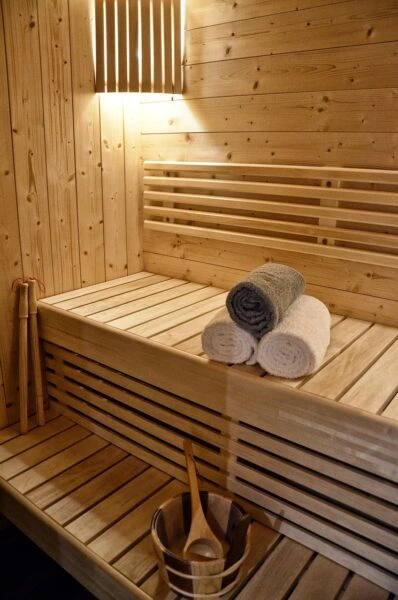Should You Hit the Sauna Before or After Your Workout?
- To get the most benefits, balance heat exposure and exercise timing. Should you sauna before or after working out? Pre-workout prepares muscles; post-workout speeds recovery.
Fitness enthusiasts commonly ask when to use the sauna – before or after working out – to get the most benefits from their workout.
Using a sauna before workout exercises gives you a head start. This helps to increase flexibility and reduce injury risk.
Relishing a sauna following your training session intensifies your recuperation. For one, it relaxes your body and mind, while at the same time flushing toxins from your body through sweating.
Whatever time you choose provides different benefits, so the best time for you depends on your individual goals and preferences.
In this post, I’ll offer tips for how you can fit sauna sessions into your regular fitness routine for maximum benefit. Doing this will help you best reap the rewards of your workouts and sharpen your recovery game efforts.
Sauna Before or After Exercise?
Should you sauna before or after working out? Timing affects your results: pre-workout may improve performance, while post-workout aids recovery. Though research often overlooks timing, strategic sauna use can optimize fitness gains.
Most athletes experience dehydration if they use a sauna before their workout. This becomes even more alarming in contexts where dehydration could have devastating consequences, such as in sport. If you’re gearing up for an event in hot weather, a pre-workout sauna session may help your body acclimate.
Post-exercise sauna use generally improves recovery. We all know how endurance workouts can make you sore and fatigued. With an infrared sauna, you’ll increase your explosive jumping power, reduce delayed-onset muscle soreness, and even enhance your subjective experience of recovery.
This post-exercise heat exposure increases circulation, bringing nutrients to fatigued muscles and removing metabolic waste. For older adults or individuals with joint pain, time spent in a sauna after exercise can help reduce post-exercise stiffness. They do need to be careful rising to avoid dehydration.
In short, first decide what your personal fitness goals are. If your main goal is to recover faster or reduce muscle soreness, then a post-workout sauna is a great option. If you’re looking to prepare your body for a demanding workout, then a brief sauna session before you work out is a good idea.
Just be sure you’re staying hydrated! Remember, while sauna use can complement your exercise routine and even offer overall health benefits, like reducing the risk of heart disease by 20%, it is not a substitute for actual exercise.
What is a Sauna?
A sauna is a sanctuary for the mind and body, beloved for millennia. Its main uses are for relaxation and relief of stress, which can be complemented by impressive health benefits. Frequent sauna use may help improve cardiovascular and metabolic health. This is what makes it such an amazing wellness practice to add to your routine!
There are two main types of saunas—traditional and infrared—each offering unique benefits depending on whether you sauna before or after working out. Traditional saunas use electric or wood-burning stoves to heat rocks, creating intense, steamy heat ideal for post-workout relaxation. Infrared saunas, which use light waves to directly warm your body, may be better suited for pre-workout sessions due to their milder, penetrating heat. Understanding these differences helps optimize your sauna use for fitness goals.
Traditional saunas heat the air around you. Infrared saunas, on the other hand, penetrate the skin, which can make for a much more comfortable sauna experience, using lower temperatures.
When in a sauna, the air is usually very hot and humid, as high as 150°F to 195°F. This heat creates a calming atmosphere that invites the body to deeply sweat. The sauna is one of the most popular detox modalities with its ability to cleanse the skin and promote circulation through sweating.
Culturally, sauna bathing is of great cultural importance to many societies. In Finland, the sauna is central to the social fabric. It acts as a social gathering space for family and friends.
Infrared sauna promotes healing. Research shows that regular sauna use can help athletes recover faster, meaning less muscle soreness after workouts. Additionally, research has demonstrated that regular sauna use can reduce the future risk of cardiovascular disease.
A study from Finland, including more than 2,000 middle-aged men, found that frequent sauna bathers have a 22% lower risk of dying from heart disease.
Sauna Before Exercise: Potential Benefits
Using a sauna shortly before working out provides many proven advantages that can boost your performance and health in important ways. Here’s a closer look at how sauna sessions can be a great way to enhance your exercise regimen.
1. Enhance Blood Flow and Warm-up
Sauna exposure induces a robust increase in circulation, which can help better prepare your muscles for the demands of exercise. As your heart rate increases while in a sauna, your body starts to get warmer.
The deep heat from a sauna loosens tight muscles and joints, making it ideal for pre-workout preparation. If you’re wondering should you sauna before or after working out, pairing sauna use with dynamic stretches can enhance your warm-up, boosting range of motion, reducing injury risk, and improving blood flow for better performance. Post-workout, this same heat aids recovery by easing soreness.
2. Boost Metabolic Activity
Heat exposure in the sauna activates your metabolism, leading to more calories burned even before you start exercising. Increased energy from this metabolic boost translates into increased energy, allowing you to feel like you’re giving more effort during your workout and resulting in better workouts.
With a little time investment, you’ll be ensuring that by incorporating sauna sessions into your pre-workout routine, your body is primed to perform at an optimal level.
3. Improve Mental Preparation
The serene atmosphere of a sauna makes it a fantastic place for mental visualization and preparation. Combining conscious breath control with the heat of the sauna can help improve relaxation and mindfulness.
By taking the time to set focused intentions for your workout in this relaxed environment, you may feel a greater impact on your performance. Using visualization techniques while in the sauna helps solidify your exercise goals.
4. Increase Body Temperature Regulation
We know sauna exposure improves the body’s ability to control temperature, equipping you to better handle temperature changes while working out. This acclimatization process may make you more tolerant of heat exposure, allowing you to better extend your training and working potential in high-temperature settings.
5. Enhance Respiratory Function
Sauna heat may help improve lung capacity, which could allow an enhanced delivery of oxygen through the body during exercise. Practicing deep breathing techniques in the sauna enhances respiratory health, an essential aspect of achieving peak performance.
Sauna Before Exercise: Potential Risks
There are a number of risks that come with using a sauna prior to working out that you should take into account. Knowing these possible downsides will allow you to take the best approach to your pre-workout regimen.
1. Risk of Dehydration
If you spend time in a sauna, your body is losing a lot of fluids in the form of sweat. This makes it very important to pay attention to your hydration status. Dehydration causes significant fatigue, dizziness, and a lowered ability to perform during your workout.
If you’re experiencing symptoms such as dry mouth, dark urine, or headaches, you’re probably already dehydrated. To avoid excessive dehydration, make sure to drink adequate fluids both before and after your sauna session. If you become dehydrated or feel faint, you should avoid the sauna altogether.
2. Potential for Overheating
Each person has a unique heat tolerance. There is an increased risk of overheating. Spending too number of time in the heat can be detrimental to your beneficial effects on workout performance.
To stay safe, limit sauna sessions to 10–15 minutes and watch for warning signs like nausea or excessive sweating. If you’re deciding should you sauna before or after working out, consider your workout intensity and sauna temperature—shorter, cooler sessions may work pre-workout, while longer sessions are better post-workout for recovery.
3. Impact on Workout Intensity
Fatigue is a risk from sauna use, which would reduce workout performance. Listen to your body and be mindful of how you feel while exercising after spending time in a sauna.
In case you experience a deterioration in energy levels, adapt your exercise regimen accordingly. To get the most out of your routine, learn to strike the ideal balance between sauna use and workout intensity. Finding this balance will maximize your results on all fronts.
4. Cardiovascular Strain Concerns
Consider your cardiovascular fitness before stepping into a sauna. This can artificially increase your heart rate, something that you don’t want to do before starting your workout.
Talk to your fitness experts about the risks and benefits of sauna use related to your specific heart health, particularly if you have pre-existing issues. Keeping an eye on your heart rate will ensure that you don’t surpass dangerous levels during your sauna session.
5. Electrolyte Imbalance
Heavy sweating in a sauna can cause a loss of valuable electrolytes. Consider replenishing these minerals after a sauna with electrolyte-rich fluids or snacks post-sauna.
Keeping your electrolytes in check is important for getting the most out of your workout. If you start to feel symptoms such as cramping or fatigue, make sure to avoid the sauna.
Sauna After Exercise: Advantages
These health benefits make sauna use after working out a powerful way to enhance your post-exercise recovery routine. This restorative practice serves to benefit our recovery and increase our well-being.
1. Promotes Muscle Recovery
Sauna heat is beneficial for post-workout muscle repair. The heat helps your blood vessels dilate, which increases circulation and delivers nutrients to fatigued muscles to speed recovery.
Adding regular sauna sessions to your post-exercise recovery routine can help produce those results. Its physiological benefits on muscle recovery are well-known, encouraging relaxation and decreased tightness in the muscles.
2. Reduces Muscle Soreness
Regular sauna use can reduce delayed-onset muscle soreness, so you’ll feel less sore post-workout. Improving your post-exercise recovery is essential, and sauna sessions offer a calming experience that relaxes sore muscles.
This is the magic of heat therapy when it comes to easing post-workout soreness, getting you back to your workouts with renewed vigor and energy.
3. Aids Lactic Acid Clearance
During sauna sessions, lactic acid that has accumulated in your muscles is cleared out, and metabolic recovery is promoted. This heat exposure helps to amplify and maximize your body’s natural processes, reducing recovery times after high-intensity, grueling workouts.
This is especially advantageous to endurance athletes, who frequently experience a lactic acid buildup from strenuous workouts.
4. Enhances Relaxation
Considered a form of passive meditation, sauna sessions are wonderful tools for stress relief, creating a peaceful atmosphere. Combining mind-soothing techniques, such as meditation, while relaxing in the sauna allows for greater peace of mind.
The calming nature of heat improves body and mind, bringing you relief after an intense gym session.
5. Improves Blood Circulation
Sauna use after workouts significantly increases blood circulation, improving cardiovascular health. Should you sauna before or after working out? Post-workout sessions enhance vascular function and oxygen delivery to muscles, making them ideal for recovery.
It should be an indispensable element of any serious exercise program!
6. Supports Cardiovascular Health
Long-term sauna use has serious cardiovascular perks. By tracking your heart’s reaction to sauna sessions, you can help build a smarter fitness plan that boosts your cardiovascular health over time.
How to Integrate Sauna Use Safely
There are many wonderful benefits to incorporating sauna sessions into your workout routine, but safety is paramount. Learning the best ways to integrate sauna use maximally empowers your workouts and relaxation. Here are some vital safety tips to keep in mind:
- Stay hydrated before and after sauna sessions.
- Limit sauna session duration to avoid overheating.
- Monitor your body’s response to heat exposure.
- Avoid alcohol and heavy meals before sauna use.
- Cool down gradually after sauna sessions.
1. Stay Hydrated
Hydration is important before and after sauna use. Increased risk of dehydration occurs when you don’t drink enough water to avoid dehydration, as the heat will lead to excess sweating. Keeping an eye on your hydration moves sauna use from smart to advantageous.
It’s not just about staying safe, but about feeling good before, during, and after your sauna session. Hydration Plan: Customize your hydration heroes to your individual needs by focusing on the intensity and/or duration of your workout.
2. Limit Session Duration
Consider time limits on sauna trips. Beginning with shorter sessions—5 to 10 minutes, for example—and slowly increasing the time allows your body to adjust to the high temperatures.
Monitor how you feel and make use of a timer to ensure you don’t overdo it and overheat.
3. Monitor the Body’s Response
Listen to your body while using the sauna. Monitor your sessions to what feels comfortable and what your heat tolerance is. If you start to feel uncomfortable or feel yourself starting to overheat, consider this your cue to leave.
Monitoring your heart rate can offer more guidance into how you’re feeling and what’s best for you.
4. Avoid Alcohol and Heavy Meals
Avoiding alcohol before you head into the sauna is a good idea, since it has a dehydrating effect.
Additionally, avoid heavy meals. Heavy meals are tough to digest, and being in the heat may exacerbate discomfort. Scheduling sauna sessions concerning meal times can help you get the most out of your time relaxing with heat.
5. Cool Down Gradually
After your sauna session, give yourself some time to cool down. Try some light stretches or movements to help your body make the transition without any shock or strain.
A cold shower or just chilling in a more temperature-appropriate space will do the trick, too. This holistic approach minimizes the shock to your system, setting you up for a more enjoyable and rewarding experience.
Optimal Sauna Session Duration
Discovering the ideal sauna session duration is key to getting the most out of your workout benefits. This is really where personal preference comes into play. Others find they do better in the sauna for 10-15 minutes. Some like to remain in for 20-30 minutes.
Above all else, it’s important to listen to your body. If you start to feel faint or in any way unwell, that’s an obvious sign that it’s time to end your sauna session.
We suggest experimenting with various durations to find out what feels best for you. Begin with shorter periods and work your way up to longer time frames as you build comfort with the heat.
To give you an example, you can start out with 10 minutes of use prior to a workout session in order to warm up muscle tissue. You’ll find that after a few sessions, you feel like you are ready to increase it up to 15 minutes or up to 20 minutes.
This trial-and-error method will help you customize your sauna sessions to best suit your individual needs. Understanding the advantages of both shorter and longer sauna sessions is important, too.
Shorter sessions increase synovial fluid production that lubricates joints, warms up muscles, and increases your range of motion. Longer sessions assist with recovery and relaxation post-workout.
If you’re wondering should you sauna before or after working out, post-workout sessions offer distinct benefits. A 15-minute sauna after exercise accelerates muscle recovery and reduces soreness, while a 30-minute session enhances detoxification and stress relief. Shorter durations work best for recovery, while longer sessions provide deeper relaxation benefits.
It’s key to pay attention to how long you’re spending in the sauna and how it’s impacting your experience. Monitor your mood before and after each session.
Using that information will help you find the perfect duration for you! Keep track of how you feel during your next workout and how quickly you recover, adapting your routine based on your notes.
Ideal Sauna Temperature and Humidity
Saunas provide a special experience that maximizes the benefits of relaxation and recovery. Here’s what you need to know to get the most out of these benefits by understanding ideal sauna temperature and humidity levels.
The ideal sauna temperature is roughly between 150 and 195 degrees Fahrenheit. At these temperatures, your body can efficiently release toxins through the sweat glands while still being surrounded by a relaxing atmosphere. For example, let’s say you’re looking for a gentler experience, you could opt for the lower end of this spectrum.
On the other hand, if you’re looking for a more hardcore experience, then a higher temperature may be more appropriate.
Humidity is one of the most important factors in determining how you feel in the sauna. Traditional dry saunas keep their humidity low, typically at 10-20%. This low humidity lets your body sweat at maximum efficiency while minimizing overwhelm.
When you enjoy a steam sauna, the humidity level can increase all the way up to an impressive 100 percent. This creates a dense, steamy, and humid environment that surrounds you. This is extremely beneficial for your respiratory system, as it clears out built-up congestion and opens up the airways to breathe more easily.
So, it’s only by experimenting with the settings you have available that you’ll find what feels best for you. A 170-degree sauna with the right balance of lower humidity can feel clarifying and invigorating. Conversely, a sauna session that’s 180 degrees offers a warm hug.
Listen to what your body is telling you. If you start to feel uncomfortable, lower the temperature or stay in the sauna for shorter periods to make the experience more enjoyable.
Understanding the role both temperature and humidity play is key to receiving the benefits of a sauna. Proper balance provides muscle relaxation, improved blood circulation, as well as skin health-improving properties.
What might work best for your body is an individual exploration process, but the benefits are certainly worth the effort.
Pre– vs. Post-Workout: Hormonal Effects
Understanding the hormonal changes that occur with sauna use before or after workouts is essential for optimizing your fitness routine. Both pre- and post-workout have their specific benefits. Most importantly, they regulate your cortisol and growth hormone levels, controlling the hormones that directly influence your workout performance and recovery.
1. Cortisol Levels
Monitoring cortisol levels is extremely important when thinking about sauna use and workout timing. Cortisol, often dubbed the stress hormone, has an important role in how your body responds to a workout.
When deciding should you sauna before or after working out, consider cortisol levels: pre-workout sauna use may spike this stress hormone, potentially improving alertness but risking overstimulation. Post-workout sauna sessions help rebalance cortisol, promoting relaxation and recovery. This hormonal regulation is why timing matters for optimal results.
When you include sauna sessions after working out, you better control your stress hormone regulation by enabling your body to recover faster and more effectively. This balance is key for peak fitness performance, as chronically high cortisol can inhibit muscle development and recuperation.
2. Growth Hormone Response
Regular sauna sessions have a powerful effect on growth hormone release, which is incredibly important for muscle growth and recovery. Spending time in a sauna increases your heart rate and blood flow.
This burst triggers an increase in your own body’s production of growth hormone. This effect is even more advanced when you combine exercise and sauna bathing together post-workout. Best of all, it fuels better recovery and greater muscle gain.
This is what makes it such a powerful tool in your fitness arsenal! When combined with regular sauna use, you can start to stack the hormonal responses in your favor, laying a great groundwork for better fitness results. Understanding the pivotal role growth hormone plays in your routine will maximize your fitness improvements. Prepare your workouts and recovery tools for maximum effectiveness!
Individual Factors to Consider
When deciding whether to use a sauna before or after a workout, it’s essential to assess individual factors that may impact your experience. Age, fitness level, and pre-existing health conditions all play critical roles in determining the best approach.
1. Age and Fitness Level
Unfortunately, one of the greatest contributors to heat tolerance is age. Younger people tend to be able to deal with more extreme heat. An aging population is uniquely affected by the increased temperature.
If you’re new to saunas and wondering should you sauna before or after working out, start cautiously. Begin with short 5-10 minute sessions to let your body adjust, especially if you’re new to fitness or in your 50s. Gradually increase duration as you acclimate. This gradual approach applies whether you use the sauna pre-workout for warming up or post-workout for recovery.
Your overall fitness level also plays a role in how you should use the sauna. If you’re a competitive athlete, consider using the sauna to help relax sore muscles after an intense workout. If you’re a beginner, focus on establishing a regular workout habit first.
Only after you are adapted should you think about adding sauna sessions to your routine. Customizing your sauna usage to align with your fitness routine will help you make the most of its benefits without pushing your body past its limits.
2. Pre-existing Health Conditions
Some pre-existing health issues may impact your time in a sauna. If you have underlying cardiovascular disease or chronic respiratory disease, please discuss with your healthcare provider first. It’s important to be in good health before entering a sauna.
They can help you with personalized advice tailored to your unique circumstances. If you’re used to managing things like high blood pressure or asthma, you can increase your safety by tailoring sauna temperature and use time.
Finally and most importantly, always keep safety at the forefront by being aware of how your health needs inform your sauna use. If you start to feel dizzy or faint, you should leave the sauna right away.
By considering your health when sauna-ing, you can safely reap the many benefits it has to offer.
Scientific Research on Sauna Timing
Knowing how to time a sauna with your workout can make a huge impact on your fitness routine. Evidence on this particular topic offers important guidance on how sauna sessions can impact your body both before and following exercise.
Research suggests that using a sauna before working out helps warm and loosen your muscles for action. The sauna’s sudden wave of heat increases your heart rate, increases circulation, warms your muscles, and can loosen tightness and tension. This sudden gain in flexibility virtually eliminates your chances of injury.
One study showed that after spending only 15 minutes in a sauna, participants experienced great improvements in muscle efficiency. Consequently, they exhibited superior performance in their following exercise bouts. This warming effect can increase your performance as well, particularly in more flexible activities like yoga or weightlifting.
Taking a sauna post-exercise can support recovery. The heat soothes your muscles and reduces soreness. It improves circulation, carrying much-needed nutrients to stressed muscles.
Studies have found that sauna use post-exercise can increase your recovery rate. It could even help with muscle building thanks to the boosted circulation! Slipping into a hot sauna following a hard workout provides instant comfort. If you have, you understand how impactful that healing is.
Staying informed on cutting-edge research with sauna timing is of critical importance. Now, new research is exploring what timing and frequency between sauna sessions is most beneficial. While these lines of scientific inquiry are ongoing, their impact on human health and performance is becoming clear.
Take, for instance, a recent study that found long-term, frequent sauna use significantly reduces the risk of cardiovascular disease.
Conclusion
Deciding whether to use a sauna before or after your workout can power up your training. Saunas are great for relaxing your muscles and enhancing recovery, too. Warm up before going to the gym to improve your entire workout and recovery experience. Or, you can chill out post-workout for the biggest payoff. Always listen to your body and think about your overarching fitness goals. The sauna is full of potential benefits and options, so treat it as an experiment. So find your rhythm and start reaping the rewards of regular sauna use. Just be cautioned to always stay hydrated and limit sauna sessions to stay safe. Tackle your next workout in a whole new way and learn how saunas can complement your routine. Take the first step toward a better sauna experience and enjoy the difference today!







